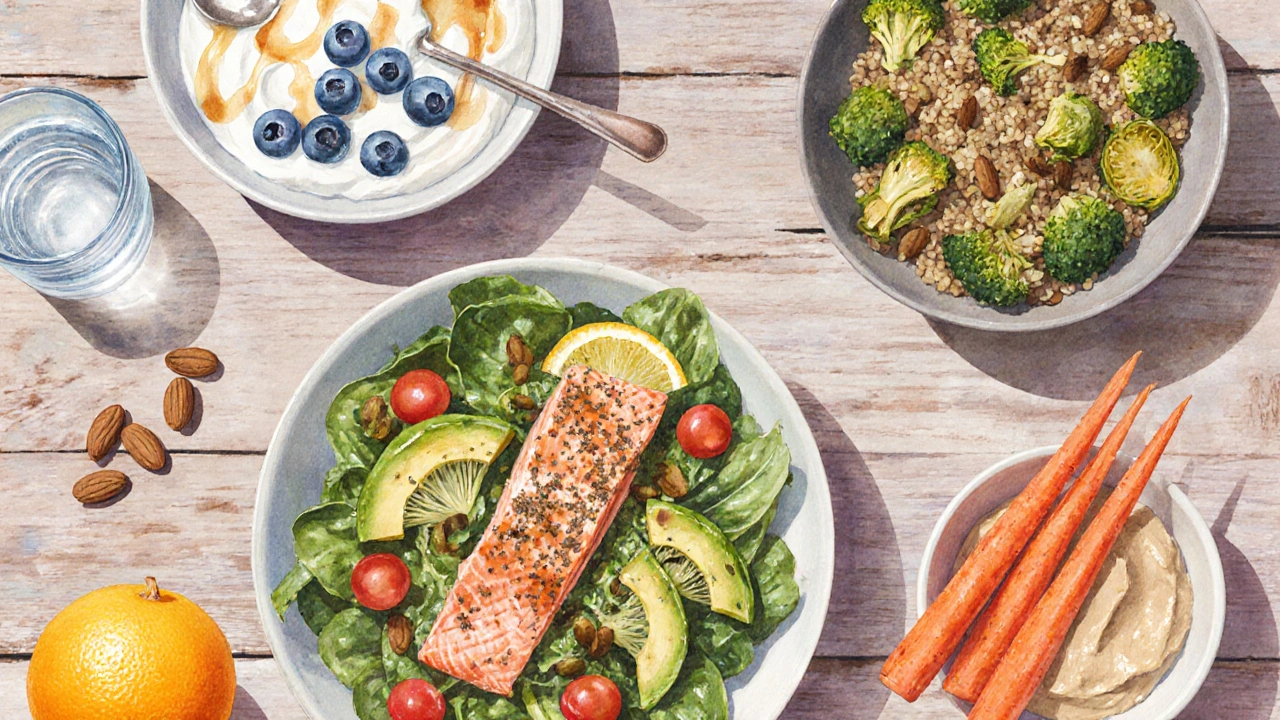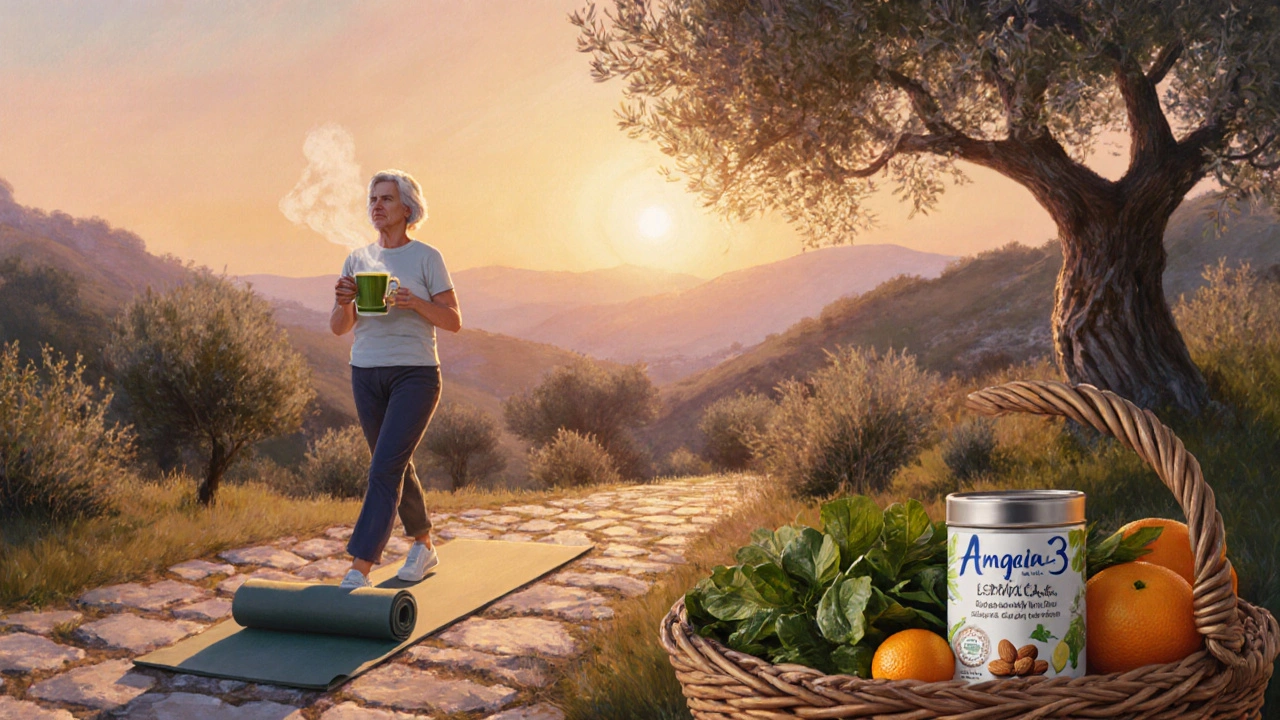
Glaucoma Nutrition Calculator
Nutrient Assessment Tool
This tool helps you calculate your daily intake of key nutrients shown to support eye health and glaucoma prevention. Enter your typical food consumption, and see how you stack up against recommended levels.
Your Daily Intake
Enter your approximate daily consumption of these glaucoma-friendly foods
Your Nutrition Assessment
Nutritional Recommendations
Your diet is currently providing 0% of your daily glaucoma-fighting nutrients.
Try adding these glaucoma-friendly foods:
- 1 serving of fatty fish 2-3x per week
- 1 cup of leafy greens daily
- A handful of nuts or seeds
- 1 cup of berries as a snack
When it comes to eye health, Open-Angle Glaucoma is a chronic condition where fluid pressure damages the optic nerve, leading to gradual vision loss. While eye‑pressure‑lowering drops are the mainstay of treatment, growing research shows that what you eat can influence disease onset and progression. Below you’ll find a practical guide that blends science with everyday cooking tips, so you can protect your sight through the meals you love.
Quick Takeaways
- Antioxidant‑rich foods (berries, leafy greens) help shield retinal cells from oxidative stress.
- Omega‑3 fatty acids support fluid drainage and lower intra‑ocular pressure.
- Foods high in lutein, zeaxanthin, and zinc improve retinal resilience.
- Adopt a Mediterranean‑style eating pattern - it consistently lowers glaucoma risk.
- Supplements can fill gaps, but they’re not a substitute for a balanced diet or professional eye care.
Understanding Open‑Angle Glaucoma
Open‑Angle Glaucoma (OAG) accounts for about 90% of glaucoma cases worldwide. The disease progresses silently; many people are unaware they have it until peripheral vision is noticeably reduced. The root cause is elevated intra‑ocular pressure (IOP), which results from impaired outflow of the aqueous humor - the clear fluid that nourishes the eye.
Key risk factors include age, family history, ethnicity (higher prevalence in African‑derived populations), and systemic conditions such as hypertension and diabetes. Nutrition doesn’t replace eye‑pressure medication, but it can modulate the physiological pathways that contribute to IOP spikes and optic‑nerve damage.
Why Nutrition Matters
Research from the National Eye Institute and several ophthalmology journals points to two main ways diet influences OAG:
- Oxidative stress reduction: The retina is exposed to high oxygen levels, making it vulnerable to free‑radical damage. Antioxidants neutralize these radicals, preserving ganglion cells.
- Inflammation control: Chronic low‑grade inflammation can stiffen the trabecular meshwork, the eye’s drainage system. Anti‑inflammatory nutrients keep the outflow channels flexible.
When you combine foods that target both mechanisms, you create a nutritional shield that works alongside prescription therapy.

Key Nutrients and Their Roles
The following nutrients have the strongest evidence for glaucoma‑friendly effects. Each is introduced with Thing microdata so search engines can index them accurately.
- Vitamin C is a water‑soluble antioxidant that protects the lens and optic nerve from oxidative damage. Recommended sources: citrus fruits, kiwi, bell peppers.
- Omega‑3 Fatty Acids (EPA/DHA) improve aqueous‑humor outflow and lower IOP. Rich in fatty fish (salmon, sardines), flaxseeds, walnuts.
- Lutein & Zeaxanthin are carotenoids that accumulate in the macula, filtering harmful blue light and reducing oxidative stress. Found in kale, spinach, corn, and egg yolks.
- Zinc is essential for retinal enzyme function and helps the eye absorb vitamin A. Good sources: oysters, pumpkin seeds, lentils.
- Vitamin E works synergistically with vitamin C to combat free radicals. Include almonds, sunflower seeds, and avocado.
- Polyphenols (found in tea, dark chocolate, berries) have anti‑inflammatory properties that support trabecular meshwork health.
- Magnesium helps regulate blood pressure, indirectly influencing IOP. Sources include leafy greens, bananas, and black beans.
- Mediterranean Diet as a pattern emphasizes many of the above nutrients while limiting processed salts that can raise blood pressure.
Building a Glaucoma‑Friendly Meal Plan
Here’s a sample day that packs the top‑rated nutrients without feeling like a diet.
- Breakfast: Greek yogurt topped with blueberries, a tablespoon of ground flaxseed, and a drizzle of honey.
- Mid‑morning snack: A small orange and a handful of almonds.
- Lunch: Spinach‑kale salad with grilled salmon, cherry tomatoes, avocado, and a lemon‑olive‑oil dressing.
- Afternoon snack: Carrot sticks with hummus (adds zinc).
- Dinner: Quinoa bowl with roasted Brussels sprouts, roasted pumpkin seeds, and a side of steamed broccoli.
- Evening beverage: Green tea (rich in polyphenols) or a cup of warm milk with a pinch of turmeric.
Adjust portions to meet your calorie needs, but keep the focus on whole, colorful foods. If you’re vegetarian, swap salmon for chia‑seed pudding or a tofu stir‑fry; the omega‑3 content stays high.
Supplements - Do They Help?
Supplements can be a handy backup when dietary intake falls short, but choose them wisely:
- Omega‑3 capsules: Aim for 1,000mg EPA+DHA combined daily. High‑quality, molecular‑distilled options minimize oxidation.
- Vitamin C: 500mg twice a day is safe for most adults, but megadoses (>2g) can cause stomach upset.
- Lutein & Zeaxanthin: 10mg lutein + 2mg zeaxanthin per day have shown measurable increases in macular pigment density.
- Zinc: 15mg elemental zinc daily is sufficient; higher doses may interfere with copper absorption.
- Multivitamin with eye‑health blend: Look for products that combine the above nutrients in balanced ratios.
Always discuss supplement plans with your ophthalmologist, especially if you’re on blood‑thinning medication, as fish‑oil can increase bleeding risk.
Lifestyle Tips Beyond Food
Nutrition is one piece of the puzzle. Pair it with these evidence‑backed habits:
- Stay hydrated - adequate fluid intake supports aqueous‑humor turnover.
- Exercise regularly (30min brisk walking most days); studies show moderate activity can lower IOP by 2-3mmHg.
- Limit caffeine to <200mg per day; excessive caffeine may cause temporary IOP spikes.
- Manage stress through mindfulness or yoga - chronic stress raises cortisol, which can affect eye pressure.
- Avoid smoking - tobacco reduces oxygen delivery to ocular tissues.

When to Seek Professional Care
Even the best diet can’t replace regular eye exams. Schedule an ophthalmology check‑up at least once a year if you have risk factors, and sooner if you notice peripheral vision loss, eye pain, or halos around lights. Your doctor can measure IOP, perform optic‑nerve imaging, and adjust medication if needed.
Comparison Table: Nutrients, Benefits, Sources, and Recommended Intake
| Nutrient | Primary Benefit for OAG | Top Food Sources | Suggested Daily Amount |
|---|---|---|---|
| Vitamin C | Antioxidant, protects optic nerve | Citrus, kiwi, red bell pepper | 90mg (women) / 110mg (men) |
| Omega‑3 (EPA/DHA) | Improves aqueous outflow, lowers IOP | Salmon, sardines, flaxseed, walnuts | 1,000mg combined EPA/DHA |
| Lutein & Zeaxanthin | Filters blue light, reduces oxidative stress | Kale, spinach, corn, egg yolk | 10mg lutein + 2mg zeaxanthin |
| Zinc | Supports retinal enzyme activity | Oysters, pumpkin seeds, lentils | 8mg (women) / 11mg (men) |
| Vitamin E | Works with Vitamin C against free radicals | Almonds, sunflower seeds, avocado | 15mg (22IU) |
Putting It All Together: A Simple Checklist
- ✔ Eat at least two servings of leafy greens daily.
- ✔ Include fatty fish or plant‑based omega‑3 sources 3× a week.
- ✔ Snack on vitamin‑C‑rich fruit each day.
- ✔ Choose whole‑grain, low‑sodium meals to keep blood pressure in check.
- ✔ Keep a supplement log and discuss it with your eye doctor.
Frequently Asked Questions
Can a specific diet reverse glaucoma?
No diet can cure glaucoma, but a nutrient‑dense eating pattern can slow progression and improve overall eye health. It works best alongside prescribed eye‑pressure medication.
Is coffee harmful for glaucoma patients?
Moderate caffeine (<200mg/day) is generally safe. Large amounts may cause a temporary rise in intra‑ocular pressure, so keep coffee intake moderate.
How much omega‑3 should I take if I don’t eat fish?
Aim for 1,000mg of combined EPA and DHA daily, using high‑quality algae‑based capsules if you avoid fish.
Are there any foods that raise eye pressure?
Very salty foods can increase systemic blood pressure, which may indirectly raise IOP. Processed snacks, canned soups, and fast‑food meals are best limited.
Should I get my vitamin D level checked?
Yes. Vitamin D deficiency is linked to higher inflammation and poorer ocular blood flow. A simple blood test can guide supplementation.
By weaving these foods and habits into your daily routine, you give your eyes the best nutritional defense against open‑angle glaucoma. Remember, the goal isn’t a quick fix-it’s a lifelong partnership between diet, lifestyle, and professional eye care.






abhi sharma
October 12, 2025 AT 06:19Oh great, another diet list – because eyeballs totally care about kale.
mas aly
October 13, 2025 AT 23:59I’ve read a few studies linking omega‑3 intake to lower intra‑ocular pressure, so adding salmon a few times a week makes sense. At the same time, you don’t have to become a full‑time pescatarian to see benefits – a spoonful of flaxseed oil works too. Pairing those fats with leafy greens that pack lutein and zeaxanthin creates a nice antioxidant combo. Just remember it’s a supplement to eye drops, not a replacement.
Abhishek Vora
October 15, 2025 AT 17:39While the enthusiasm is understandable, the literature is more nuanced than a simple “eat more fish” mantra. Randomized controlled trials have shown modest IOP reductions, typically around 1‑2 mmHg, which may not be clinically significant for all patients. Moreover, bioavailability of lutein from raw kale can vary based on cooking method, with lightly steamed leaves retaining more of the carotenoid. Zinc status is also crucial, as it facilitates retinal enzyme activity, yet excessive supplementation can interfere with copper metabolism. Therefore, a balanced approach that considers individual dietary patterns and medical history is advisable.
maurice screti
October 17, 2025 AT 11:19When one attempts to distill the complex interplay between nutrition and glaucoma into a handful of bullet points, the result often feels like an oversimplified infographic.
Nevertheless, the body of evidence accumulated over the past two decades does suggest that certain micronutrients exert measurable effects on ocular physiology.
Omega‑3 fatty acids, particularly EPA and DHA, have been implicated in enhancing the outflow of aqueous humor, thereby modestly reducing intra‑ocular pressure.
The mechanistic underpinnings involve alterations in the composition of the trabecular meshwork extracellular matrix, a process that may be mediated by anti‑inflammatory eicosanoids.
Equally compelling is the role of lutein and zeaxanthin, which concentrate in the macular pigment and serve as a photoprotective shield against blue‑light‑induced oxidative stress.
Clinical trials employing 10 mg of lutein plus 2 mg of zeaxanthin daily have reported increases in macular pigment optical density, correlating with slower visual field loss in certain cohorts.
Zinc, though required only in trace amounts, is a cofactor for superoxide dismutase, an enzyme pivotal in neutralising reactive oxygen species within the retina.
Dietary sources such as oysters or pumpkin seeds provide bioavailable zinc, yet supplementation should be capped at 15 mg per day to avoid copper antagonism.
Vitamin C and vitamin E together create a synergistic antioxidant network, scavenging free radicals that would otherwise damage retinal ganglion cells.
Polyphenol‑rich foods like tea, dark chocolate, and berries introduce flavonoids that exhibit modest anti‑inflammatory properties, which may preserve trabecular flexibility.
Magnesium, often overlooked, contributes to vascular tone regulation; adequate intake supports systemic blood pressure control, an indirect conduit to intra‑ocular pressure management.
The Mediterranean dietary pattern elegantly merges these components, emphasizing fish, nuts, leafy vegetables, and olive oil while limiting processed sodium.
Adherence to such a pattern has been associated with a 20‑30 % reduction in glaucoma incidence in epidemiological studies, though causality remains to be definitively proven.
It is crucial, however, to contextualize these findings within the broader therapeutic regimen, as pharmacologic agents remain the cornerstone of disease control.
Patients should therefore view nutrition as an adjunctive strategy, a dietary scaffolding that may enhance, but not replace, prescribed eye‑drops or surgical interventions.
In practice, a realistic plan might involve two servings of fatty fish per week, a daily cup of dark leafy greens, a handful of nuts, and a serving of berries, complemented by a modest omega‑3 supplement if dietary intake falls short.
Abigail Adams
October 19, 2025 AT 04:59The recommendation reads like a culinary manifesto, yet it glosses over the socioeconomic barriers that prevent many patients from accessing such “premium” foods. While the scientific premises are sound, the tone borders on moralizing, implying that those who cannot afford salmon are somehow negligent in their eye care. A more inclusive approach would acknowledge budget‑friendly alternatives, such as canned sardines or fortified plant‑based oils, without compromising the underlying message. Moreover, the suggestion to supplement without explicit reference to potential drug‑nutrient interactions may inadvertently encourage unsupervised self‑medication.
Belle Koschier
October 20, 2025 AT 22:39I think the key takeaway is that a varied, plant‑forward diet can complement medical therapy without turning every meal into a laboratory experiment. Simple swaps-like adding a sprinkle of pumpkin seeds to a salad or swapping a sugary snack for a handful of berries-are easy to adopt and can incrementally boost those eye‑supporting nutrients. Consistency over perfection is what ultimately matters for long‑term ocular health.
Allison Song
October 22, 2025 AT 16:19One could argue that nourishment is an act of self‑respect, a tacit acknowledgement of the body’s fragility and its capacity for renewal. When we feed our eyes with antioxidants, we are, in a sense, honoring the very sense through which we perceive the world, creating a feedback loop of gratitude and preservation.
Joseph Bowman
October 24, 2025 AT 09:59Ever notice how the big pharma ads never mention diet as a “cure” for glaucoma? It’s almost as if there’s a hidden agenda to keep us hooked on expensive eye drops while the simple truth about leafy greens stays buried. I’m not saying it’s a grand conspiracy, but it wouldn’t hurt to question why the narrative never shifts toward natural prevention.
Singh Bhinder
October 26, 2025 AT 03:39It’s an interesting point – the emphasis on medication does dominate the conversation, yet there are plenty of peer‑reviewed studies highlighting dietary impact. Balancing both perspectives might give patients a more rounded view of their options.
Mia Michaelsen
October 27, 2025 AT 21:19In addition to the mentioned nutrients, choline found in eggs also supports retinal cell membrane integrity, a fact often omitted from popular guides.
Kat Mudd
October 29, 2025 AT 14:59The data on nutritional interventions in glaucoma is surprisingly extensive yet constantly misinterpreted by mainstream outlets because they lack the analytical depth to parse heterogeneous study designs and variable dosing regimens which leads to public confusion and misguided health choices the meta‑analyses consistently reveal modest effect sizes that are statistically significant but clinically modest which means that while diet can play a supportive role it should never be hailed as a standalone therapy the real challenge lies in translating these nuanced findings into practical guidelines that clinicians can readily prescribe without overwhelming patients with jargon the solution may involve interdisciplinary collaboration between ophthalmologists nutritionists and primary care providers to craft individualized plans that respect patient preferences and socioeconomic realities ultimately a balanced approach that integrates evidence‑based nutrition with standard pharmacotherapy offers the best chance of preserving vision while minimizing side effects